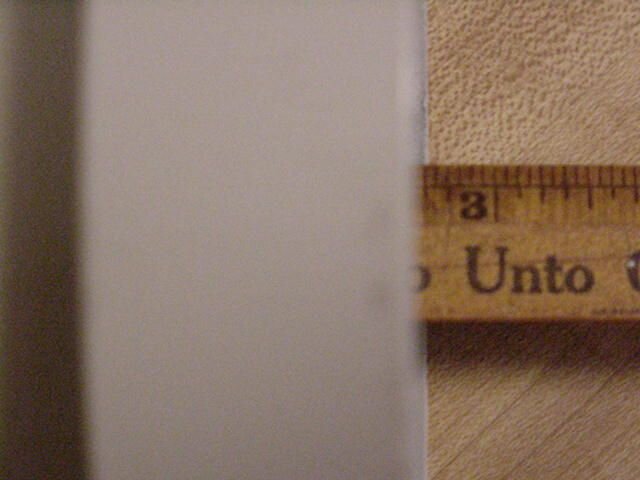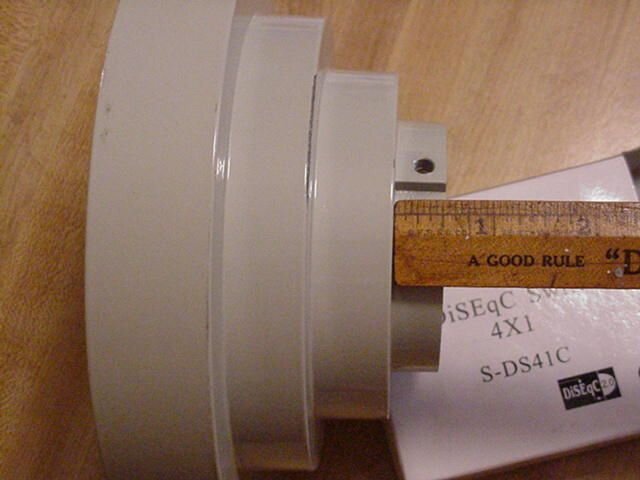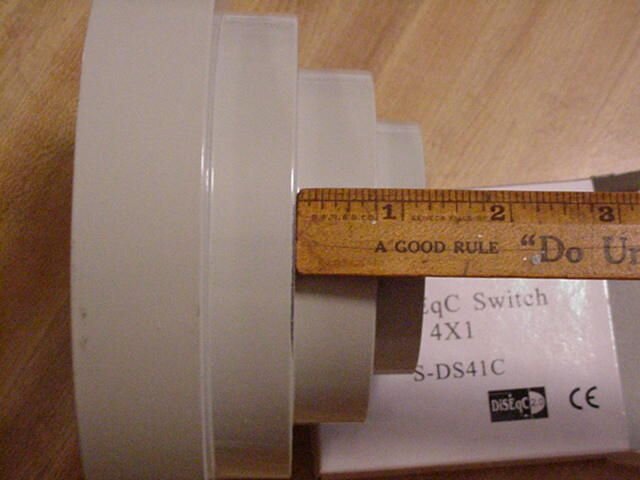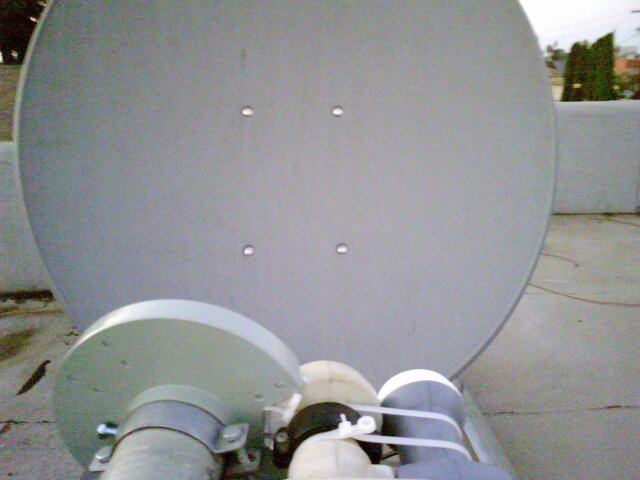Primestar 84E/BSC621-2 LNBF Experiment
- Thread starter satcom1
- Start date
- Latest activity Latest activity:
- Replies 271
- Views 42K
You are using an out of date browser. It may not display this or other websites correctly.
You should upgrade or use an alternative browser.
You should upgrade or use an alternative browser.
- Status
- Please reply by conversation.
Blaines Farm and Fleet
Hi Bloomdog,
I got a roll of aluminum flashing at farm & fleet :up, on sale for $5.89, small roll.
This stuff is really springy, which makes it good for fabricating cones. I can't believe the prices they want for aluminum stock today. I used tin snips to cut it out and then used Crazy Glue to secure the seams.
I have software that is written specifically for feedhorn calculations, both conical and rectangular. It's been used for years and is well proven and very simple to use.!sadroll
I have made this feedhorn by inputing the parameters into another software program that produces a 3-D ( you don't need the red and blue glasses) image and a printer plot to use as template.
image and a printer plot to use as template.
I have two other conical feedhorns. One for a larger C-Band LNBF and one for the Invacom SNH-031 KU-Band LNBF.
I want to make a test with the Invacom KU which has a Conical Scalar Ring built inside and a 15 dBi Conical Feedhorn to see if it will improve the already good performance of this LNBF.
 The dimensions are posted just prior to yours.
The dimensions are posted just prior to yours.
Good looking feedhorn. WHat is it made of? What are the dimensions and how did you arrive at them?
Thanks for sharing................
Hi Bloomdog,
I got a roll of aluminum flashing at farm & fleet :up, on sale for $5.89, small roll.
This stuff is really springy, which makes it good for fabricating cones. I can't believe the prices they want for aluminum stock today. I used tin snips to cut it out and then used Crazy Glue to secure the seams.
I have software that is written specifically for feedhorn calculations, both conical and rectangular. It's been used for years and is well proven and very simple to use.!sadroll
I have made this feedhorn by inputing the parameters into another software program that produces a 3-D ( you don't need the red and blue glasses)
I have two other conical feedhorns. One for a larger C-Band LNBF and one for the Invacom SNH-031 KU-Band LNBF.
I want to make a test with the Invacom KU which has a Conical Scalar Ring built inside and a 15 dBi Conical Feedhorn to see if it will improve the already good performance of this LNBF.
 The dimensions are posted just prior to yours.
The dimensions are posted just prior to yours.Buy fabricating and fitting extensions to the prime focus Scalar Ring it is possible to increase the Signal Quality.
Using HITN-TV as a benchmark a SQ of 31-33% fluctuating level was recorded.
By adding the fabricated metal strips to the first and second rings a SQ of 41% was recorded.
Very nice Satcom1.
Your C-Band Mini-Bud
Popcorn-
Thanks for posting your link (see subject) in another thread. Man you did a great job with your C-Band set up. I was really impressed at how professional your work is.
Very nice Satcom1.
Popcorn-
Thanks for posting your link (see subject) in another thread. Man you did a great job with your C-Band set up. I was really impressed at how professional your work is.
Conical Feedhorn
Here are the results of todays testing.
Using my benchmark channel the BSC-621-2 was installed on the fabricated dish arm.
The Scalar ring and lnbf were peaked at 35% Signal Quality.
The Scalar ring was removed and the Conical Feedhorn was installed and peaked at 31% SQ.
The Conical Feedhorn was removed and the lnbf was peaked at 34% SQ without a Scalar ring.
The Scalar ring was installed and peaked at 35% SQ.
The plastic lens cap was removed and signal went to 37% SQ.
Plastic lens cap from China may contain lead. :yikes
An Aluminum foil surrond was installed on the outer edge of the Scalar Ring.
A SQ of 38% was recorded. Please note how much the lnbf came forward of the Scalar ring to tune properly.
Here are the results of todays testing.
Using my benchmark channel the BSC-621-2 was installed on the fabricated dish arm.
The Scalar ring and lnbf were peaked at 35% Signal Quality.
The Scalar ring was removed and the Conical Feedhorn was installed and peaked at 31% SQ.
The Conical Feedhorn was removed and the lnbf was peaked at 34% SQ without a Scalar ring.
The Scalar ring was installed and peaked at 35% SQ.
The plastic lens cap was removed and signal went to 37% SQ.
Plastic lens cap from China may contain lead. :yikes
An Aluminum foil surrond was installed on the outer edge of the Scalar Ring.
A SQ of 38% was recorded. Please note how much the lnbf came forward of the Scalar ring to tune properly.
Attachments
do you have a scalar ring that has not been cut on to try to see if there is a difference in that way also.
All the same
 :
:
Yes, I have two other Scalar rings uncut. They all work the same.
They all work the same.
I can't find a magic bullet for imroving small dish performance.
do you have a scalar ring that has not been cut on to try to see if there is a difference in that way also.
 :
:Yes, I have two other Scalar rings uncut.
I can't find a magic bullet for imroving small dish performance.
Those pictures above look really good, I'm impressed..!
Here are some pictures for you. I tried posting this last night and the site went down. Boy that sure ticked me off. I felt like I wasted 20-30 minutes? I took 17 pictures and one wouldn't unload from the camera, when I looked at it, it only showed the top part of the picture, so that one is missing. Here are the other 16, the first with Flash, the others without Flash. As you will notice, I'm not so good with a camera. Also, This is the only ruler I have, and I hope you can read it? I do not have good lighting in my house, sorry about that.Do you still have one?
If so can you take picture with ruler next to it?
The side view picture is helpfull, I can scale steps using 65 mm throat as ruler but need inside details.
Once detailed drawing is made then it will be simple to make or have made. But there is alot of magic and art in the design of this item and using a known good example is priceless.
Attachments
-
 Conical-11.JPG33.9 KB · Views: 198
Conical-11.JPG33.9 KB · Views: 198 -
 Conical-10.JPG33.9 KB · Views: 184
Conical-10.JPG33.9 KB · Views: 184 -
 Conical-09.JPG33.7 KB · Views: 189
Conical-09.JPG33.7 KB · Views: 189 -
 Conical-08.JPG39 KB · Views: 175
Conical-08.JPG39 KB · Views: 175 -
 Conical-07.JPG30.8 KB · Views: 195
Conical-07.JPG30.8 KB · Views: 195 -
 Conical-06.JPG39.9 KB · Views: 188
Conical-06.JPG39.9 KB · Views: 188 -
 Conical-05.JPG33 KB · Views: 181
Conical-05.JPG33 KB · Views: 181 -
 Conical-04.JPG43.3 KB · Views: 201
Conical-04.JPG43.3 KB · Views: 201 -
 Conical-02.JPG39.4 KB · Views: 217
Conical-02.JPG39.4 KB · Views: 217 -
 Conical-01.JPG65.5 KB · Views: 197
Conical-01.JPG65.5 KB · Views: 197 -
 Conical-17.JPG38.1 KB · Views: 187
Conical-17.JPG38.1 KB · Views: 187 -
 Conical-16.JPG38.5 KB · Views: 196
Conical-16.JPG38.5 KB · Views: 196 -
 Conical-15.JPG43.4 KB · Views: 170
Conical-15.JPG43.4 KB · Views: 170 -
 Conical-14.JPG33.3 KB · Views: 181
Conical-14.JPG33.3 KB · Views: 181 -
 Conical-13.JPG32.7 KB · Views: 180
Conical-13.JPG32.7 KB · Views: 180 -
 Conical-12.JPG33.5 KB · Views: 166
Conical-12.JPG33.5 KB · Views: 166
Conical Scalar Ring Dimensions
Voomvoom-
You made my day!
Those are very good pictures and I appreciate all the effort you went to to get this posted.:up:up:up:up
That is good enough documentation to take to the work shop and make one.
Voomvoom-
You made my day!
Those are very good pictures and I appreciate all the effort you went to to get this posted.:up:up:up:up
That is good enough documentation to take to the work shop and make one.
Excellent!!!!!!!!!!!!
:up:up:up:up:up:up
Voomvoom-- three cheers!!! Good job!!! I am inspired to follow in your footsteps and build my own. I spent all day yesterday experimenting with no results.
A few questions, if you don't mind:
1. what material(s) did you use?
2. do the inner rings taper at all? in other words, are these cones within cones or are all of the walls of the rings perpendicular to the face plate of the lnbf?
3. What is the space (distance) between each ring?
4. how did you attach each ring to its base?
5. can you make a few diagrams and post them? please show all the parts with all the measurements before you assembled them.
6. What size dish are you using?
7. what is your f/D ratio?
8. How did you know what all the measurements were to be? Do you have software or formulae for this? I have been all over the internet trying to learn as much as I can as to what the dimensions should be for a conical scalar ring. I have found smatterings of information. According to my reading, each ring height should be more then 1/4 of the wavelength of the signal one seeks and less than 1/2 of the wavelength of that signal--- that's pretty darn small (I made a chart of my calculations for C-Band). Not sure if it's correct--just what I read. Also, I believe I understand the theory behind concentric scalar rings and also understand the theory behind having a cone/funnel. My surmise is that your design is a hybrid of both--is that correct?
General Comment: Has anyone tried a rectangular feed horn for C-Band??--very interesting information posted on the internet for this shape horn. Results looked intriguing.
Thanks a million!!!!!!!!!!!!:up:up:up:up:up:up:up:up:up
:up:up:up:up:up:up
Voomvoom-- three cheers!!! Good job!!! I am inspired to follow in your footsteps and build my own. I spent all day yesterday experimenting with no results.
A few questions, if you don't mind:
1. what material(s) did you use?
2. do the inner rings taper at all? in other words, are these cones within cones or are all of the walls of the rings perpendicular to the face plate of the lnbf?
3. What is the space (distance) between each ring?
4. how did you attach each ring to its base?
5. can you make a few diagrams and post them? please show all the parts with all the measurements before you assembled them.
6. What size dish are you using?
7. what is your f/D ratio?
8. How did you know what all the measurements were to be? Do you have software or formulae for this? I have been all over the internet trying to learn as much as I can as to what the dimensions should be for a conical scalar ring. I have found smatterings of information. According to my reading, each ring height should be more then 1/4 of the wavelength of the signal one seeks and less than 1/2 of the wavelength of that signal--- that's pretty darn small (I made a chart of my calculations for C-Band). Not sure if it's correct--just what I read. Also, I believe I understand the theory behind concentric scalar rings and also understand the theory behind having a cone/funnel. My surmise is that your design is a hybrid of both--is that correct?
General Comment: Has anyone tried a rectangular feed horn for C-Band??--very interesting information posted on the internet for this shape horn. Results looked intriguing.
Thanks a million!!!!!!!!!!!!:up:up:up:up:up:up:up:up:up
Last edited:
DIY Conical Scalar Ring
Bloomdog-
If you can take a regular C-Band Scalar ring and cut each circular section and then re-attach them to form a stepped ring you would be very close to what voomvoom has.
The enjoyment of this hobby is in part the enthusiasm one gets when inspired by an idea.......go for it.:up:up
:up:up:up:up:up:up
Voomvoom-- three cheers!!! Good job!!! I am inspired to follow in your footsteps and build my own. I spent all day yesterday experimenting with no results.
A few questions, if you don't mind:
1. what material(s) did you use?
You can use aluminum or plastic and then copper leaf the inside.
2. do the inner rings taper at all? in other words, are these cones within cones or are all of the walls of the rings perpendicular to the face plate of the lnbf?
The commercial unit VoomVoom has is stepped perpendicular walls, mine is cone and ring design.
3. What is the space (distance) between each ring?
Let the standard Scalar be your guide.
4. how did you attach each ring to its base?
I used Super Glue. voomvooms' is cast pot metal.
5. can you make a few diagrams and post them? please show all the parts with all the measurements before you assembled them.
6. What size dish are you using?
7. what is your f/D ratio?
8. How did you know what all the measurements were to be? Do you have software or formulae for this? I have been all over the internet trying to learn as much as I can as to what the dimensions should be for a conical scalar ring. I have found smatterings of information. According to my reading, each ring height should be more then 1/4 of the wavelength of the signal one seeks and less than 1/2 of the wavelength of that signal--- that's pretty darn small (I made a chart of my calculations for C-Band). Not sure if it's correct--just what I read. Also, I believe I understand the theory behind concentric scalar rings and also understand the theory behind having a cone/funnel. My surmise is that your design is a hybrid of both--is that correct?
I have used some very expensive commercial software over the years in antenna design. But in the end you must take it to the RF anachoic chamber and adjust using trial and error. But even at the Andrews Lab it is up to the intuition and experience of the engineer to create a fine antenna.
I did antenna evaluations for years in cellular and there is a lot of CRAP that people buy and swear by because of advertising image.
General Comment: Has anyone tried a rectangular feed horn for C-Band??--
Rectangular feedhorn is for a rectangular waveguide opening in LNBF.
very interesting information posted on the internet for this shape horn. Results looked intriguing.
Thanks a million!!!!!!!!!!!!:up:up:up:up:up:up:up:up:up
Bloomdog-
If you can take a regular C-Band Scalar ring and cut each circular section and then re-attach them to form a stepped ring you would be very close to what voomvoom has.
The enjoyment of this hobby is in part the enthusiasm one gets when inspired by an idea.......go for it.:up:up
If I am at zip 90006 what should my motor & Dish elevation be?
I can track all the sats but some are not were they should be.
Some sats are about 1 or 2 degrees off from there actual location.
Pole is level as it should be.
I can track all the sats but some are not were they should be.
Some sats are about 1 or 2 degrees off from there actual location.
Pole is level as it should be.
Attachments
Last edited:
That's correct, I bought 2 of them from brotherhood, at least I think it was brotherhood. He had a cousin in Japan, who got them for him/us. Do a search in the Classified's and you should find something on them? Last I remember, he was asking for interest to get some more?bloomdog
He bought it from a member here who got them from overseas
I found the thread here:
http://www.satelliteguys.us/free-air-fta-discussion/129705-offset-scaler-ring.html
And in post # 43, he is asking for interest to get some more....
Last edited:
Placed my raincheck
Thanks, voomvoom-
i just PM'd Brotherhood for one.
That's correct, I bought 2 of them from brotherhood, at least I think it was brotherhood. He had a cousin in Japan, who got them for him/us. Do a search in the Classified's and you should find something on them? Last I remember, he was asking for interest to get some more?
I found the thread here:
http://www.satelliteguys.us/free-air-fta-discussion/129705-offset-scaler-ring.html
And in post # 43, he is asking for interest to get some more....
Thanks, voomvoom-
i just PM'd Brotherhood for one.
Dish Elevation Adjustment
Dreanfox1-
Use these values to double check your setup. See Screen Shots.
The protractor is very accurate and takes into account for slop and manufacturing error in Post, motor and dish. 50.42 minus 24.62 degree dish offset = 25.8 on protractor. With motor at zero.
50.42 minus 24.62 degree dish offset = 25.8 on protractor. With motor at zero.
All the SG2100 motors have a problem with the motor bracket deforming as you tighten the clamps down. Some of the brackests are made with lopsided arms. What you can do to correct this is make a rigid backer plate out of electrical box covers 4" x 4" with four holes drilled in them for the clamp rods. Then use flat washers 5/16" id X 6 at each hole. Place the washers between the bracket and the plates and double nut everything. If you need more help with that search sg2100. Stogie posted some pictures of his method.
On the dish protractor you should read the dish elevation from the screen shot at www.satsig.net 50.42 degrees. 50.42 minus 24.62 degree dish offset = 25.8 on protractor. With motor at zero.
The manual says your bracket elevation should be 56 degrees which is what your picture shows, but it is better if you use the Latitude scale on the other side of the bracket set to 34 degrees.
Your dish bracket angle should be about 24.5 degrees. But use the protractor and set the dish elevation bracket to what the protractor says. Completely disregard Declination. !sadroll
 Yes, you set the pole plumb and level. but put a torpedo level across the top of the motor at the two cast lugs and check level again. Also check the back of the motor clamps for plumb.
Yes, you set the pole plumb and level. but put a torpedo level across the top of the motor at the two cast lugs and check level again. Also check the back of the motor clamps for plumb.
If I am at zip 90006 what should my motor & Dish elevation be?
I can track all the sats but some are not were they should be.
Some sats are about 1 or 2 degrees off from there actual location.
Pole is level as it should be.
Dreanfox1-
Use these values to double check your setup. See Screen Shots.
The protractor is very accurate and takes into account for slop and manufacturing error in Post, motor and dish.
All the SG2100 motors have a problem with the motor bracket deforming as you tighten the clamps down. Some of the brackests are made with lopsided arms. What you can do to correct this is make a rigid backer plate out of electrical box covers 4" x 4" with four holes drilled in them for the clamp rods. Then use flat washers 5/16" id X 6 at each hole. Place the washers between the bracket and the plates and double nut everything. If you need more help with that search sg2100. Stogie posted some pictures of his method.
On the dish protractor you should read the dish elevation from the screen shot at www.satsig.net 50.42 degrees. 50.42 minus 24.62 degree dish offset = 25.8 on protractor. With motor at zero.
The manual says your bracket elevation should be 56 degrees which is what your picture shows, but it is better if you use the Latitude scale on the other side of the bracket set to 34 degrees.
Your dish bracket angle should be about 24.5 degrees. But use the protractor and set the dish elevation bracket to what the protractor says. Completely disregard Declination. !sadroll
 Yes, you set the pole plumb and level. but put a torpedo level across the top of the motor at the two cast lugs and check level again. Also check the back of the motor clamps for plumb.
Yes, you set the pole plumb and level. but put a torpedo level across the top of the motor at the two cast lugs and check level again. Also check the back of the motor clamps for plumb.Attachments
Last edited:
- Status
- Please reply by conversation.
Similar threads
- Replies
- 8
- Views
- 602
- Replies
- 3
- Views
- 76
- Replies
- 21
- Views
- 2K
- Replies
- 4
- Views
- 619






 :
:










